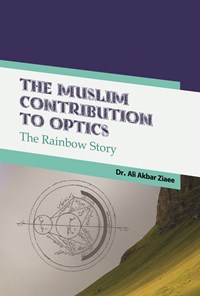
کتاب The Muslim Contribution to Optics, The Rainbow Story
معرفی کتاب The Muslim Contribution to Optics, The Rainbow Story
کتاب The Muslim Contribution to Optics, The Rainbow Story نوشتهٔ علیاکبر ضیایی در انتشارات بین المللی امین چاپ شده است.
درباره کتاب The Muslim Contribution to Optics, The Rainbow Story
The formation of rainbow was considered as a basic problem in the optical sciences from ancient time to the Middle Ages, both in the East and the West. The Rainbow is an optic and metrological phenomenon, an arc of concentric colored bands, single circular arc of non repeating colors, one of the most spectacular light shows observed on earth, and a most charming example of chromatic dispersion. All of us have admired the majestic beauties of a rainbow. For many centuries, the rainbow has been worshiped as god and goddess, and sometimes feared as demon.
Almost every society from the East to the West has considered the rainbow its private preserve, not surprisingly the bow has assumed many disguises. In the ancient Greece the rainbow is named Iris, and she as a representative of Gods often dread messages of war and punishment. The rainbow has functioned as a bridge to heavens in many different ways.
For many centuries some people consider the rainbow an ominous snake arching across the sky, while Judeo-Christian culture imagines it to be a bridge between the gods and humankind. In Judeo-Christian culture, the rainbow is connected with divine promises of peace and compassion. The ancient Greeks thought these arcs of color were signs from the gods to warn people that terrible wars or storms were going to happen. The Norse people believed a rainbow was a bridge the gods used to walk down from the sky to the Earth. Other legends said there was a pot of gold waiting at the end of a rainbow.
Several of the most famous medieval Muslim philosophers, mathematicians, astronomers, and physicians studied the fundamental nature and function of vision and of light. The science of Islamic optics is probably the most original and important scientific explorations and findings in the history of the Islamic world. These scientists studied the works of Greek scientists, most notably, works written by the mathematician Euclid in the third century BC and treatises that the Egyptian astronomer Ptolemy produced four hundred years later. This pre-Islamic and rich literature explored an encyclopedic range of topics, from reflection, refraction, image projection through openings, and the rainbow, to the anatomy and workings of the eye. It was some time before Islamic scientists, building from this base, developed a more unified approach to optical phenomena as a whole. The most recognizable Islamic contributors to rainbow phenomena were: the Alexandrian mathematician/astronomer Ibn al-Haytham (Alhazen 965–1039), FÉrÉbÊ, the Persian physician Ibn Sīnā (Ibn Sian 980–1037), Ibn Rushd, Iranian philosopher QuÏb al-DÊn ShÊrÉzÊ (1236–1311), and Kamāl al-Dīn al-Fārisī (d. 1320), Surawardi, and Hocazâde. The works of these great philosophers based on the inductive reasoning. They have discussed this natural phenomenon and each of them contributed to Islamic optics and natural sciences. The work of these scientists greatly advanced the development of method in experiment, in particular the importance of correlation between experiment and theory. By the efforts of them, experimental science was taking shape, utilizing the kind of investigative process that ultimately came to dominate all scientific enterprise. In this research, I try to portrait the history of rainbow from ancient time to Ottoman Empire in general and Hocazâde’s treatise on rainbow in particular.
کتاب The Muslim Contribution to Optics, The Rainbow Story را به چه کسانی پیشنهاد میکنیم
این کتاب به علاقهمندان به مطالعهٔ تاریخ علم در اسلام و نقش مسلمانان در پیشبرد علومی نظیر نورشناسی پیشنهاد میشود.
حجم
۵٫۰ مگابایت
سال انتشار
۱۳۹۶
تعداد صفحهها
۸۵ صفحه
حجم
۵٫۰ مگابایت
سال انتشار
۱۳۹۶
تعداد صفحهها
۸۵ صفحه